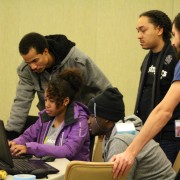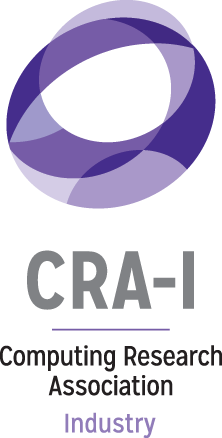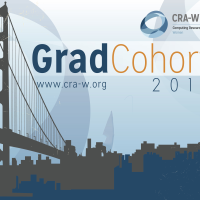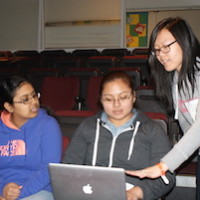Broadening Participation African Americans in the U.S. Computing Sciences Workforce
Originally Printed in Communications of the ACM
By: Juan E. Gilbert, Jerlando F.L. Jackson, Edward C. Dillon Jr., and LaVar J. Charleston
Broadening participation in computing has received a great deal of media coverage recently on diversity challenges in Silicon Valley.2,8 Major Silicon Valley technology companies, including Dell and Intel, have released employment data and the lack of diversity has caused many to question their commitment.2 For example, Intel has committed $300 million over the next five years to improve the company’s workforce diversity.8
As employment data is released for the technology workforce in Silicon Valley and other technology hubs, an important question emerges: How are Ph.D.-granting computing departments doing regarding the representation of African Americans? In this column, we examine efforts to increase Ph.D. and faculty production for African Americans in computing sciences through the work of a new project funded by the National Science Foundation—Institute for African-American Mentoring in Computing Sciences (iAAMCS, pronounced “i am c s”). The data presented in this column is from the Computing Research Association (CRA) Taulbee Survey and the NSF Survey of Earned Doctorates (SED) Tabulation Engine.
African American Ph.D. and Faculty Production Landscape
Table 1 contains data from 2003 to 2013 on computer sciences (CS) Ph.D. production for African Americans from the CRA Taulbee Survey and the NSF Survey of Earned Doctorates that uses data from the National Center for Science and Engineering Statistics (NCSES). Taylor and Ladner7 first reported differences in the CRA Taulbee Survey data and the WebCASPAR data. Therefore, this column will use data from both sources with respect to Ph.D. production to show the contrast. Both datasets show an increase in the raw number of African American CS Ph.D.’s produced; however, the total percentage distribution among Ph.D.’s has not changed much. There is at least a 50% increase in the raw number of Ph.D.’s produced, but the total percentage distribution remains relatively flat. Clearly, the overall CS Ph.D. production has increased at a rate that limits increases in the percentage. However, does this increase in overall CS Ph.D. production among African Americans result in an increase in African American faculty?
Table 2 captures the African American CS tenure-track faculty from 2003 to 2013 from the CRA Taulbee Survey. Table 2 only counts faculty in Ph.D.-granting departments that participate in the Taulbee survey. Broader surveys of African American faculty and their ranks do not seem to exist. This data shows more improvement compared to the Ph.D. production data. At all ranks, there is more than a 100% increase for African Americans in CS tenure-track faculty positions from 2003 to 2013. These numbers are promising, but there is still much work to be done. The fact that the highest concentration levels for assistant, associate, and full professors has been respectively 3.50%, 1.80%, and 0.80% are very low. There is opportunity for improvement within the academy. So, why are these numbers so low with respect to African American CS tenure-track faculty and Ph.D. production? How can these numbers be improved?
Gibbs et al.1 conducted a study of 1,500 recent American BMS (biomedical sciences) Ph.D. graduates (including 276 underrepresented minorities) that examined career preferences over the course of their graduate training experiences. Their findings showed a disproportionately low interest among underrepresented minorities and women in pursuing an academic career at a research university upon completing graduate school compared to their White and Asian male counterparts. The article also stated that scientists from underrepresented backgrounds, which included American Indian/Alaska Native, Black/African American, Hispanic/Latino, or Native Hawaiian/Pacific Islander, earn 10% of life science Ph.D.’s and that number had remained unchanged since 1980, which is better than CS Ph.D. production for African Americans and all underrepresented groups combined.
Considering these numbers, it would appear there are many African Americans and other underrepresented minorities pursuing science and engineering Ph.D.’s; however, so few chose CS. Data from many decades ago suggests African Americans do not pursue science, technology, engineering, and mathematics (STEM) degrees because of cultural stigmas (including sentiments such as it’s not cool to be a scientist or scientists are nerds). Hager and Elton3 surveyed college freshmen and Sewell and Martin6 surveyed high school juniors. In these two studies, they found African American men expressed a greater interest in social service fields compared to White men, who prefer STEM disciplines. In general, African American college students are highly represented in disciplines such as education, humanities, and social sciences.5 Hall and Post-Kammer4 reported African Americans choose these disciplines because they have a cultural orientation and expectation to help others. Historically, STEM disciplines are generally not seen as disciplines that can be used to help others. Do these cultural stigmas still apply and are they the reason for the low representation of African Americans in CS Ph.D. programs? If so, one possible solution could be to show examples of how computing research can have an impact on society. That is, demonstrate how computing can change lives and improve the human condition, especially for African Americans. Connecting computing to solving human conditions that will likely impact communities of color is one of the primary goals of the iAAMCS.
Emerging National Resource for Diversifying Computing Sciences
The iAAMCS is a NSF Broadening Participation in Computing (BPC) Alliance (see http://www.iaamcs.org). The mission of iAAMCS is to: increase the number of African Americans receiving Ph.D. degrees in computing sciences; promote and engage students in teaching and training opportunities; and add more diverse researchers into the advanced technology workforce. iAAMCS provides various activities that serve as interventions for increasing interest in computing sciences among underrepresented minorities with a particular focus on African Americans, as described here.
Faculty and student training. This activity consists of face-to-face workshops and webinars for African American (and other underrepresented) students and their advisors to provide a shared context for the completion of the research experience. The students received training in time management, managing expectations, and research processes (for example, literature review, source control, and so forth). The advisor’s training is based on documented differences between mentoring by effective and non-effective teachers of African American (and other underrepresented) students.
Academic year undergraduate research (AYUR). The purpose of AYUR is to increase the African American Ph.D. pipeline by introducing second-semester freshmen and sophomore African American students in computing to research. Specifically, the objectives of AYUR are to: develop undergraduate research competence in a computing area such as robotics, game programming, mobile applications, or other computing research area; increase critical inquiry and critical thinking associated with conducting research; increase active engagement through a research experience (presentations, competitions, and so forth); develop a repository of models of effective undergraduate research mentoring; and ultimately, increase the number of African American computing students with an interest in pursuing graduate degrees in CS. AYUR also encourages students to extend their research beyond this activity and pursue other research opportunities (for example, REUs).
Distributed research experiences for undergraduates (DREU). Similar to AYUR, DREU is an activity that provides research opportunities to African American (and other underrepresented) students in preparation for graduate school. This activity accepts applications from students and mentors who are then matched based on interests and backgrounds. During DREU, students complete a 10-week research experience that consists of several checkpoints in the process to ensure uniform expectations and outcomes. The DREU program is a collaboration between the CRA-W (Computing Research Association’s Committee on the Status of Women in Computing Research) and the CDC (Coalition to Diversity Computing).
Technical webinars and distinguished lecture series (DLS). DLS is an activity that provides targeted presentation interventions for African American students (and other underrepresented groups) in computing sciences. Topics include: computing research, academic faculty employment, research scientist positions, and other topics related to the benefits of getting a Ph.D. in computing sciences. Each presentation is an hour long with a period dedicated for the mentor leading the session to answer questions from attendees. These lectures are held onsite at the host institution that places the request for the lecture.
Distinguished fellows writing workshop (DFWW). DFWW serves as a platform for African American undergraduate and graduate students (and other underrepresented groups) to learn the process of writing a competitive application for summer internships, graduate school, and/or external funding. The targeted audience for this activity is junior and senior-level undergraduates and first- and second-year students as well as faculty that advise or mentor these students.
K–12 outreach. This activity provides opportunities for African American undergraduate and graduate students (and other underrepresented groups) to work with middle and high school students through computing awareness and exposure events, after-school programs, and summer camps. The goal of these programs is to provide opportunities for low-income and middle-class African American, Latino, and female students to explore computer science and develop programming and computational thinking skills. Through graduate and undergraduate participation in these programs, we aim to provide middle school and high school students with role models with similar racial and gender backgrounds to help them develop identities as computer scientists. For the graduate and undergraduate facilitators we aim to provide opportunities for them to give back to communities with similar demographics as the ones they came from and to help bolster their skills and identities as computer scientists.
ARTSI robotics competition. iAAMCS is the sponsor of (and provides some funding for) the ARTSI robotics competition. The objective of this competition is to develop an active robotics community for African American (and other underrepresented) students and recruit them to pursue graduate training and careers in research. This competition is held annually at the ACM Richard Tapia Celebration of Diversity in Computing Conference.
Tapia Celebration of Computing in Diversity Conference. iAAMCS sponsors students to attend this event. The premise of this activity is that there are professionals across the U.S. who are interested in supporting African American (and other diverse) students. Members of iAAMCS are both highly visible and deeply aware of who many of those individuals are. Underrepresented minority and female students are much less aware of those individuals. So the vision is that identifying and engaging this group of individuals could serve as a strong resource, both as role models and mentors for these students. When a broad group of diverse students interact with each other, there are benefits given their common bond of being underrepresented.
Conclusion
Currently, iAAMCS is in its second year as an organization. It is developing a model to engage, support, and sustain students via a national network. Building upon the prior relationships and networks developed by related organizations such as ELA and XSEDE, iAAMCS participants are connected to a larger network of peers, faculty, and computing professionals to meet the student’s individual interests and needs. iAAMCS participants also join a network of individuals across the country, building a virtual (and sometimes in-person) network. This allows for any individual student, faculty member, or computing professional across the U.S. to become connected to others as a part of iAAMCS, including (in fact targeting) those that are not a member of any partnering institution. If iAAMCS meets its objectives, there should be shifts in the numbers of African Americans pursuing and receiving Ph.D.’s in CS. There should also be a continued increase in their representation in CS tenure-track faculty positions at all ranks. The iAAMCS projects are designed to provide mentoring, support, and a different perspective of computing for all underrepresented minorities with a focus on African Americans.
References
1. Gibbs, K.D., Jr., McGready, J., Bennett, J.C., Griffin, K. Biomedical science Ph.D. career interest patterns by race/ethnicity and gender. PLoS ONE 9, 12 (Dec. 2014) e114736: DOI: 10.1371/journal.pone.0114736.
2. Guynn, J. Intel pledges diversity by 2020, invests $300 million. USA Today (2015); http://www.usatoday.com.
3. Hager, P.C. and Elton, C.F. The vocational interests of Black males. Journal of Vocational Behavior 1 (1971), 153–158.
4. Hall, E.R. and Post-Kammer, P. Black mathematics and science majors: Why so few? Career Development Quarterly 35 (1987), 206–219.
5. Powell, L. Factors associated with the underrepresentation of African-Americans in mathematics and science. The Journal of Negro Education 59, 3 (1990), 292–298.
6. Sewell, T.E. and Martin, R.P. Racial differences in patterns of occupational choice in adolescents. Psychology in the Schools 13, (1976), 326–333.
7. Taylor, V. and Ladner, R. Data trends on minorities and people with disabilities in computing. Commun. ACM 54, 12 (Dec. 2011), 34–37.
8. Vara, V. Can Intel make silicon valley more diverse? The New Yorker (2015); http://www.newyorker.com.
Authors
Juan E. Gilbert (juan@juangilbert.com) holds the Andrew Banks Family Preeminence Endowed Chair and is the associate chair of research in the Computer and Information Science and Engineering Department at the University of Florida where he leads the Human-Experience Research Lab.
Jerlando F. L. Jackson (jjackson@education.wisc.edu) is the Vilas Distinguished Professor of Higher Education and the director and chief research scientist of Wisconsin’s Equity and Inclusion Laboratory (Wei LAB) at the University of Wisconsin-Madison.
Edward C. Dillon, Jr. (ecdillon@cise.ufl.edu) the iAAMCS project manager and a postdoctoral associate in the Computer and Information Science and Engineering Department at the University of Florida.
LaVar J. Charleston (charleston@wisc.edu) is the assistant director and a senior research associate at Wisconsin’s Equity and Inclusion Laboratory (Wei LAB) within the Wisconsin Center for Education Research at the University of Wisconsin-Madison.
Footnotes
The CRA Taulbee Survey contains information on the enrollment, production, and employment of Ph.D.’s in computer science and computer engineering (CS and CE) and demographic data for faculty in CS and CE in North America. It also includes data on gender and ethnicity breakdowns. Known limitations of Taulbee Survey data include: reporting universities can vary from year to year and reporting universities are only a subset of all Ph.D.-granting institutions, but generally cover all the top producing institutions.
This material is based in part upon work supported by the National Science Foundation under Grant Number CNS-1457855. Any opinions, findings, and conclusions or recommendations expressed in this material are those of the authors and do not necessarily reflect the views of the National Science Foundation.






